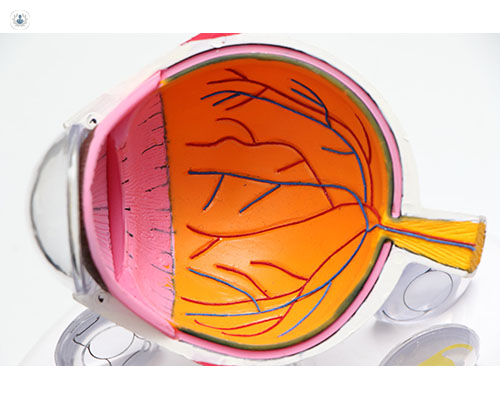An expert insight into vitreoretinal surgery
Escrito por:Vitreoretinal surgery refers to surgical procedures that treat conditions affecting the retina and the vitreous, which is the gel-like substance inside the eye. In severe cases, these surgeries can be critical to prevent vision loss.
Mr Tafadzwa Young-Zvandasara, leading consultant ophthalmic surgeon, provides an expert insight into vitreoretinal surgery, addressing common patient questions.

What eye conditions require vitreoretinal surgery?
Vitreoretinal surgery is required to treat eye conditions that affect the retina or vitreous, including: retinal detachment, macular holes, epiretinal membranes, complications of diabetic retinopathy, vitreous haemorrhage, floaters, and severe eye infections or trauma.
How is vitreoretinal surgery performed?
Vitreoretinal surgery is performed under local anaesthesia with sedation, though general anaesthesia may be used in some cases. On the day of the procedure, your ophthalmic surgeon will first insert small ports less than 1mm wide, in the sclera (the white part of the eye). Through these incisions, your surgeon will then insert microsurgical instruments into the eye.
The specifics of your vitreoretinal surgery procedure will depend on the exact condition being treated, but most surgeries will involve a procedure known as a vitrectomy, in which your surgeon will remove the vitreous gel from the eye. This will allow better access to the retina and to prevent it from pulling on the retina or clouding vision.
Depending on the specific eye condition, your surgeon will then either:
- Drain fluid under the retina and inject a gas bubble or silicone oil to press the retina back into place.
- Remove any tissue pulling on the retina and fill the eye with a gas or air bubble to close and repair a macular hole.
- Use a laser to seal off abnormal blood vessels or remove scar tissue causing retinal detachment.
Once the retinal condition has been addressed, the space left by the removed vitreous gel will be filled with either a gas or air bubble, or with silicone oil. The small incisions made in the sclera are usually self-sealing and so won’t require stitches. At the end of the surgery, your surgeon will place a protective patch or shield over the eye to prevent injury and infection.
Are there any risks associated with vitreoretinal surgery?
As with any surgical procedure, there are risks associated with vitreoretinal surgery, including infection, increased intraocular pressure, bleeding, and cataract formation in older patients, after the procedure. However, most complications are rare.
What should I expect during recovery after vitreoretinal surgery?
After vitreoretinal surgery, you will typically be given eye drops to prevent infection and reduce inflammation. It's essential to follow the instructions on how and when to use these medications.
If a gas bubble or oil was used during surgery, you may also be required to maintain a specific head position, such as lying face down, for a few days. This positioning will help ensure that the bubble presses against the retina, allowing it to heal properly.
Lastly, for several weeks after surgery, you will need to avoid strenuous activities, heavy lifting, and any activities that could put pressure on the eye. Your surgeon will give you a personalised timeline for when it’s safe to resume normal activities.
How long does it take for vision to improve after vitreoretinal surgery?
For most patients, vision will gradually improve over a period of several weeks to months. In some cases, full visual recovery will take up to six months, especially for complex conditions like retinal detachment or macular hole.
If you would like to book an appointment with Mr Young-Zvandasara, head on over to his Top Doctors profile today.


